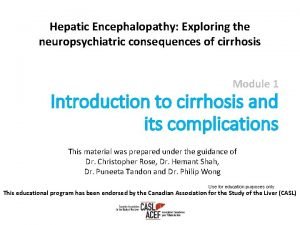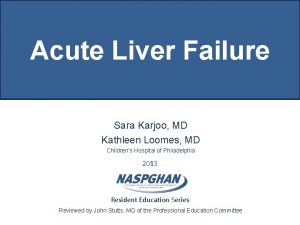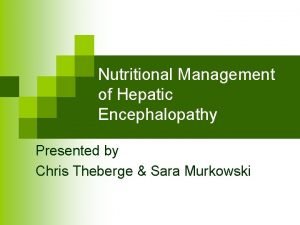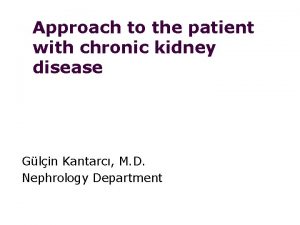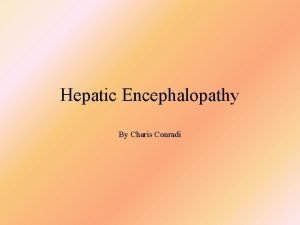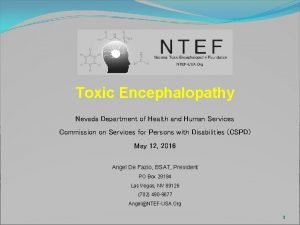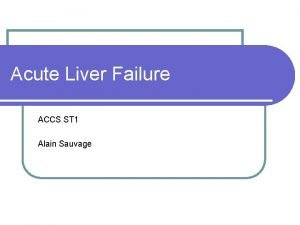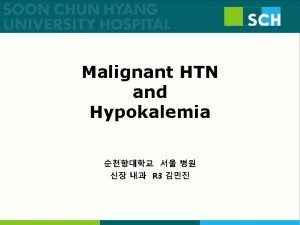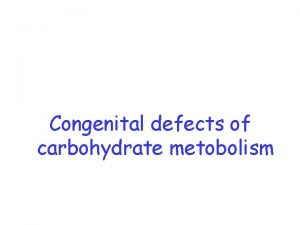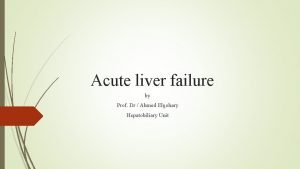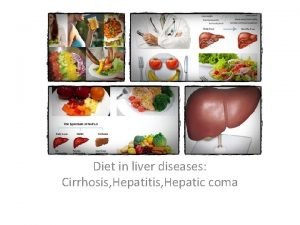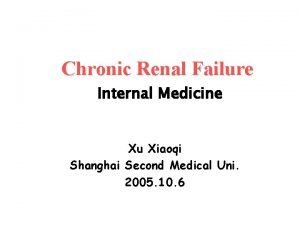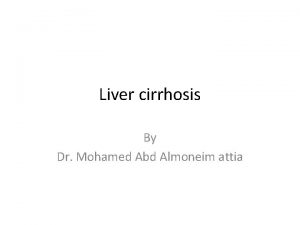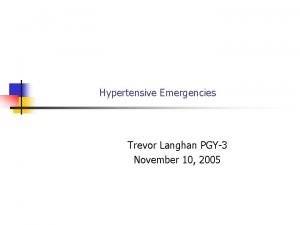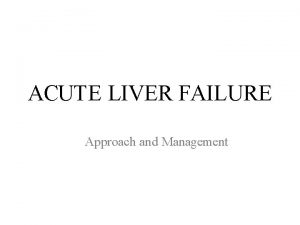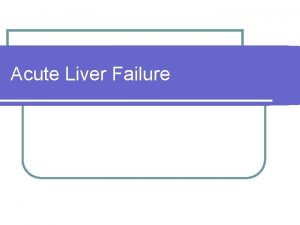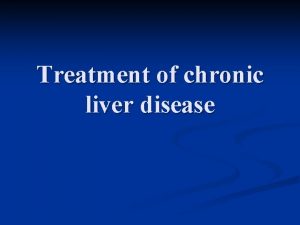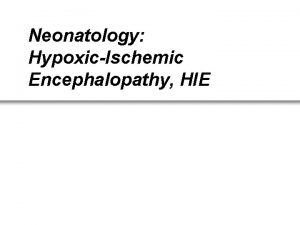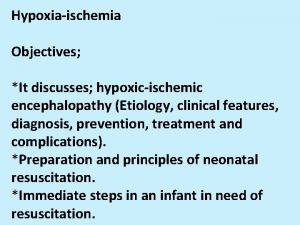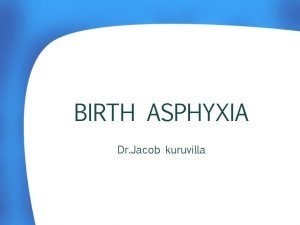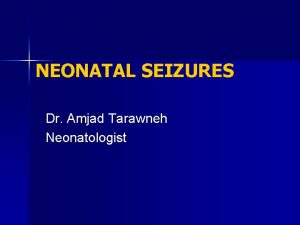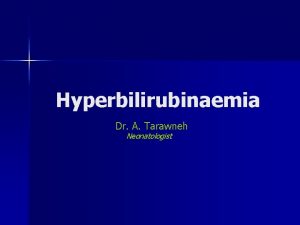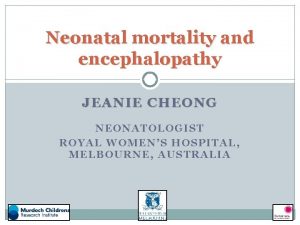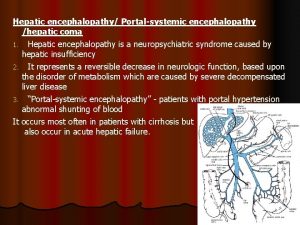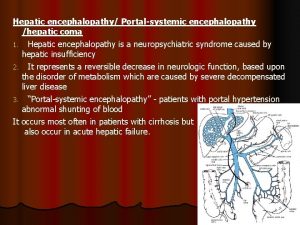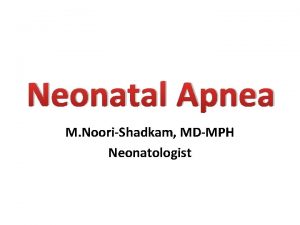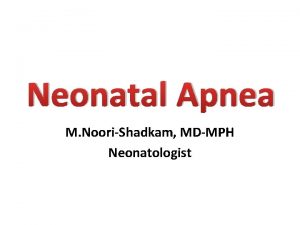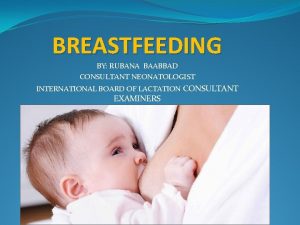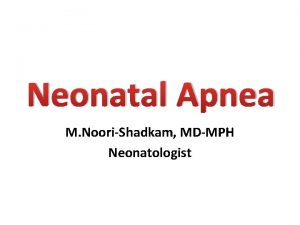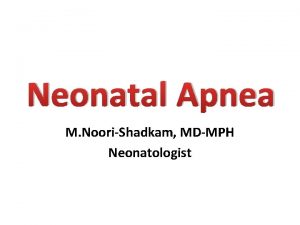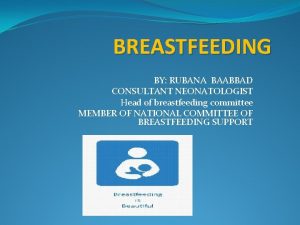HypoxicIschemic Encephalopathy Dr A Tarawneh M D Neonatologist













































- Slides: 45

Hypoxic-Ischemic Encephalopathy Dr. A. Tarawneh M. D , Neonatologist

DEFINITIONS § Hypoxic-Ischemic Encephalopathy : § abnormal neurologic behavior in the neonatal period arising as a result of a hypoxic-ischemic event. § The severity of hypoxic-ischemic encephalopathy (HIE) can be defined depending on symptoms and signs § § § Mild moderate severe

DEFINITIONS § Hypoxia or Anoxia : § Partial (hypoxia) or complete (anoxia) lack of oxygen in the brain or blood. § Asphyxia : § This is the state in which placental or pulmonary gas exchange is compromised or ceases typically producing a combination of progressive hypoxemia and hypercapnia. § Ischemia : This is reduction (partial) or cessation (total) of blood flow to an organ (such as the brain), which compromises both oxygen and substrate delivery to the tissue.

Incidence � Incidence – 2 -4 cases per 1000 births � Mortality rate – Severe HIE the mortality rate has been reported to be 50 -75% – Most deaths (55%) occur in the first week of life due to multiple organ failure

SELECTIVE VULNERABILITY n A number of factors influence the distribution of brain injury, summarized as follows: § § Cellular susceptibility Maturity Vascular territories Regional susceptibility § Type of hypoxic-ischemic insult

SELECTIVE VULNERABILITY n Cellular Susceptibility : n Maturity – The neuron is the most sensitive cellular element to hypoxic-ischemic insult, followed by cells cerebral vasculature. – Gestational age plays an important role in the changing susceptibility of cerebral structures to hypoxic-ischemic insult. n n n Hypoxic-ischemic insult before 20 weeks’ gestational age, polymicrogyria during midgestation (26 to 36 weeks) predominantly damage white matter, leading to periventricular leukomalacia Insults at term (35 weeks and beyond) predominantly damage deep gray matter (posterior putamen and ventrolateral nucleus of the thalamus).

SELECTIVE VULNERABILITY n Vascular Territories – Watershed injury : refers to tissue damage that occurs in regions that are most vulnerable to reduction in cerebral perfusion n n These tissues are at the furthest points of arterial anastomoses and are exposed to damage when perfusion pressure falls, usually as the result of impaired cardiac output. In the term brain, – – – the parasagittal region The paracentral gyrus The motor cortex n are particularly liable to watershed injury this accounts for the observation that spastic cerebral palsy is the most common major sequela to hypoxic-ischemic insult at term. – the hippocampus, temporal lobe, and occipital lobes are most resistant to this type of insult.

Types of Hypoxic-Ischemic Insult § Acute total asphyxia § This produced injury to the § Thalamus § brainstem § spinal cord structures § partial asphyxial insult lasting 1 to 5 hours § This produced damage predominantly in the § cerebral hemispheres § basal ganglia § cerebellum.

PATHOPHYSIOLOGY n Early or primary neuronal damage occurs as a result of cytotoxic changes due to n n failure of the microcirculation inhibition of energy-producing molecular processes increasing extracellular acidosis and failure of Na+/K+-adenosine triphosphatase (ATPase) membrane pumps – which results in excessive leakage of Na+ and Cl- into the cell with consequent accumulation of intracellular water (cytotoxic edema) n Free radical production is also initiated, which further n If not reversed, these processes lead to neuronal death within a short time of the acute insult compromises neuronal integrity

PATHOPHYSIOLOGY The primary physiological processes that lead to HIE � Systemic hypoxemia � Reduced cerebral blood flow (CBF)

PATHOPHYSIOLOGY n Early compensatory adjustments n Hypoxia and hypercapnia – Increase in the CBF n Increase cardiac output n BP increase n Early compensatory adjustments fail n BP falls – CBF falls below critical levels n Brain suffers from diminished blood supply n Lack of sufficient oxygen to meet its needs.

PATHOPHYSIOLOGY

PATHOPHYSIOLOGY � During the early phases of brain injury, brain temperature drops n n Local release of neurotransmitters, such as (GABA) increase Reduce cerebral oxygen demand, transiently minimizing the impact of asphyxia

PATHOPHYSIOLOGY n The magnitude of the final neuronal damage depends – – Initial insult Damage due to energy failure Reperfusion injury Apoptosis

PATHOPHYSIOLOGY

HIE History � AAP Criteria n n Profound metabolic acidosis Mixed acidemia (p. H <7) in an umbilical artery blood sample Persistence of an Apgar score of 0 -3 for longer than 5 minutes Neonatal neurological sequelae (e. g. , seizures, coma, hypotonia)

History � AAP Criteria n Multiple organ involvement (e. g. , kidney, lungs, liver, heart, intestines) � On rare occasions, n Difficulties with delivery n Particularly problems with delivering the head

HIE Physical Examination � Mild HIE n n Muscle tone may be slightly increased Deep tendon reflexes may be brisk during the first few days Poor feeding, irritability, or excessive crying or sleepiness , may be observed. By 3 -4 days of life, the CNS examination findings become normal

HIE Physical Examination � Moderate HIE n Lethargy n Significant hypotonia n Diminished deep tendon reflexes. n Grasping, Moro, and sucking reflexes may be sluggish or absent. n The infant may experience periods of apnea.

HIE Physical Examination � Moderate HIE continue n Seizures may occur within the first 24 hours of life. n Full recovery within 1 -2 weeks----better longterm outcome.

HIE Physical Examination � Severe HIE – – – – Stupor or coma is typical Breathing may be irregular Generalized hypotonia and depressed deep tendon reflexes are common. Neonatal reflexes are absent. Disturbances of ocular motion Nystagmus Pupils may be dilated, fixed, or poorly reactive to light

HIE � Classification of HIE by Sarnat 1976 � Stage I n n n n Consciousness: Hyperalert Reflexes: Overactive Tone: Normal Suck: Weak Pupil: Mydriasis Heart: Tachycardia EEG: Normal Duration: 1 -3 days

HIE � Stage II n Consciousness: Lethargic n Reflexes: Overactive n Tone: Mild hypotonia n Suck: Weak n Pupil: Miosis n Heart: Bradycardia n EEG: Low voltage n Duration: 2 -14 days

HIE � Stage III n Consciousness: Stuporous n Reflexes: Absent n Tone: Flaccid n Suck: Absent n Pupil: Unequal, poor light reflex n Heart: Bradycardia n EEG: Low voltage n Duration: 2 -14 days

ETIOLOGY n Fetal hypoxia may be caused by various disorders in the mother, including (1) inadequate oxygenation of maternal blood (1) (2) (3) (4) hypoventilation during anesthesia cyanotic heart disease respiratory failure or carbon monoxide poisoning (2) low maternal blood pressure (1) acute blood loss (2) spinal anesthesia (3) compression of the vena cava and aorta by the gravid uterus (3) inadequate relaxation of the uterus to permit placental filling as a result of uterine tetany caused by the administration of excessive oxytocin (4) premature separation of the placenta (5) impedance to the circulation of blood through the umbilical cord as a result of compression or knotting of the cord (6) placental insufficiency from toxemia or postmaturity

ETIOLOGY n After birth, hypoxia may be caused by (1) failure of oxygenation as a result of severe forms cyanotic congenital heart disease § severe pulmonary disease (2) anemia severe enough to lower the oxygen content of the blood § n n severe hemorrhage hemolytic disease (3) shock severe enough to interfere with the transport of oxygen to vital organs from n n n overwhelming sepsis massive blood loss intracranial or adrenal hemorrhage

Risk Factors

Multiorgan Systemic Effects of Asphyxia § Central nervous system § Cardiovascular § Pulmonary § § § § Hypoxic-ischemic encephalopathy infarction intracranial hemorrhage seizures, cerebral edema Hypotonia hypertonia § § Myocardial ischemia poor contractility, tricuspid insufficiency hypotension § § § Pulmonary hypertension pulmonary hemorrhage respiratory distress syndrome

Multiorgan Systemic Effects of Asphyxia n Renal n n Adrenal n n n n n Perforation ulceration hemorrhage necrosis Metabolic n n Adrenal hemorrhage Gastrointestinal n n Acute tubular or cortical necrosis Inappropriate secretion of antidiuretic hormone hyponatremia hypoglycemia Hypocalcemia myoglobinuria Subcutaneous fat necrosis Hematology n Disseminated intravascular coagulation

Differential Diagnosis n n n Inborn errors of metabolism Neuromuscular disorders Neonatal myopathies Brain tumors Developmental defects Infections

Work-up n Serum electrolytes n In severe cases – Daily assessment of serum electrolytes are valuable – SIADH n Renal function studies n Cardiac and liver enzymes n Coagulation system evaluation n ABG

HIE Imaging Study � MRI n Loss of cerebral gray and white matter differentiation n Basal ganglia or thalamus injury n Parasagittal cerebral injury n Decreased signal in the posterior limb of the internal capsule

HIE � Imaging � Head CT scanning n n Cerebral edema Ventricular hemorrhage � Echocardiogram n n Myocardial contractility Structural heart defects

HIE � EEG n Continuous n Seizures low voltage pattern

HIE � Treatment – Maintain adequate ventilation. – Maintain adequate perfusion. n Maintain the mean blood pressure (BP) above 35 -40 – Maintain adequate metabolic status – Seizures should be treated with : n n phenobarbital or lorazepam phenytoin can be added if persistent

HIE � Hypothermia Treatment – Mild hypothermia 3 -4°C below the baseline temperature – Mechanism of action n n n Reduced metabolic rate Energy depletion Decreased excitatory transmitter release Reduced ion flux Reduced apoptosis Reduced vascular permeability, edema, and disruptions of blood-brain barrier functions.

HIE � Hypothermia Treatment � Timing of initiation of hypothermia therapy: n n Cooling must begin early, within 1 hour of injury Favorable outcome may be possible if the cooling begins within 6 hours after injury � The greater the severity of the initial injury, the longer the duration of hypothermia needed for optimal neuroprotection

HIE � Hypothermia Treatment � Selective head cooling n Acap (Cool. Cap) with channels for circulating cold water is placed over the infant's head, and a pumping device facilitates continuous circulation of cold water. Nasopharyngeal or rectal temperature is then maintained at 34 -35°C for 72 hours � Whole body cooling n Infant is placed on a commercially available cooling blanket, through which circulating cold water flows, so that the desired level of hypothermia is reached quickly and maintained for 72 hours

HIE � Surgical Care – Posterior cranial fossa hematoma, surgical drainage may be life saving if no additional pathologies are present � Consultations – Pediatric neurologist should help assist in the management of seizures, interpretation of EEG � Diet – Nothing by mouth (NPO) during 1 st 3 DOL or until the general level of alertness and consciousness improves – Begin trophic feeding – Monitor for NEC n n n � PT Abdominal girth Gastric residuals Stools

PREVENTION n PRIMARY PREVENTION – RESUSCITATION n following steps should be taken in sequence until the infant responds adequately: – – – Provide tactile stimulation. Open airway. Extend the infant’s neck and give chin support. Inflate lungs Use a self-inflating bag and mask if spontaneous respirations have not been established by 30 to 60 seconds – Consider giving the infant five lung inflations (pressure of 30 cm of water in a term infant) for 2 to 3 seconds each. – Ventilate lungs. If spontaneous respiration has not been established after five inflations, start intermittent positive pressure ventilation at 30 breaths/min.

PREVENTION – RESUSCITATION cont – Intubate. If the infant has not improved after 2 minutes of intermittent positive pressure ventilation – Use chest compression. If the heart rate is <60 bpm despite adequate ventilation. Coordinate compressions and ventilation in a 3: 1 to achieve 90 compressions and 30 breaths per minute. – Administer drugs. Epinephrine (10 μg/kg or 0. 1 m. L/ kg of 1: 10, 000) should be given down the endotracheal tube if the heart rate remains below 60 beats/min, and can be repeated up to three times. – Epinephrine and other drugs can also be given through an umbilical catheter. – volume expansion with normal saline – Intramuscular naloxone (200 μg) is indicated if the infant fails to breathe spontaneously and if the mother has received opiates for pain relief within 4 hours before delivery.

PREVENTION n Conditions in Which the Need for Resuscitation at Birth May Be Anticipated n n Maternal – – – Uteroplacental – – – n Toxemia (eclampsia) Diabetes mellitus Drug addiction Cardiovascular disease Infectious disease Collagen vascular disease Placental abruption Umbilical cord prolapse Placenta previa Polyhydramnios Premature rupture of the membranes Intrapartum Factors – – – – – Isoimmunization Multiple birth Abnormal presentation Precipitous delivery Fetal distress Thick meconium staining Prolonged labor Difficult forceps delivery Intrauterine growth restriction Prematurity

PREVENTION � Prevention – Allopurinol: is an inhibitor of xanthine oxidase and has free radical scavenging action – High-dose phenobarbital : (40 mg/kg) was associated with a significant reduction in severe neurodevelopmental disability – Excitatory amino acid (EAA) antagonists : Magnesium sulfate (Mg. SO 4) is an N-methyl-d-aspartate receptor antagonist and has been proposed to be an effective agent for brain protection

Prognosis � Good Prognostics n Normal EEG at 7 DOL � Poor prognostics n n n No spontaneous respiratory effort within 20 -30 minutes Seizures is an ominous sign Abnormal clinical neurological findings >7 -10 DOL Persistent feeding difficulties Poor head growth during the postnatal period

Thank you
 Lactulose mechanism of action
Lactulose mechanism of action Mdcalc childs pugh
Mdcalc childs pugh Asterixis in hepatic encephalopathy
Asterixis in hepatic encephalopathy Precipitants of hepatic encephalopathy
Precipitants of hepatic encephalopathy Bilirubin encephalopathy
Bilirubin encephalopathy Nephropathy
Nephropathy Hepatic encephalopathy staging
Hepatic encephalopathy staging Acute toxic encephalopathy icd 10
Acute toxic encephalopathy icd 10 Encephalopathy stages
Encephalopathy stages Malignant hypertension treatment
Malignant hypertension treatment Galactosemia
Galactosemia Posology formula
Posology formula Hepatic coma diet
Hepatic coma diet Hashimoto encephalopathy diagnostic criteria
Hashimoto encephalopathy diagnostic criteria Uremic encephalopathy
Uremic encephalopathy Hepatic precoma definition
Hepatic precoma definition Hypertensive encephalopathy
Hypertensive encephalopathy Encephalopathy stages
Encephalopathy stages West haven hepatic encephalopathy
West haven hepatic encephalopathy Hepatic encephalopathy pathophysiology
Hepatic encephalopathy pathophysiology Cholycystostomy
Cholycystostomy

